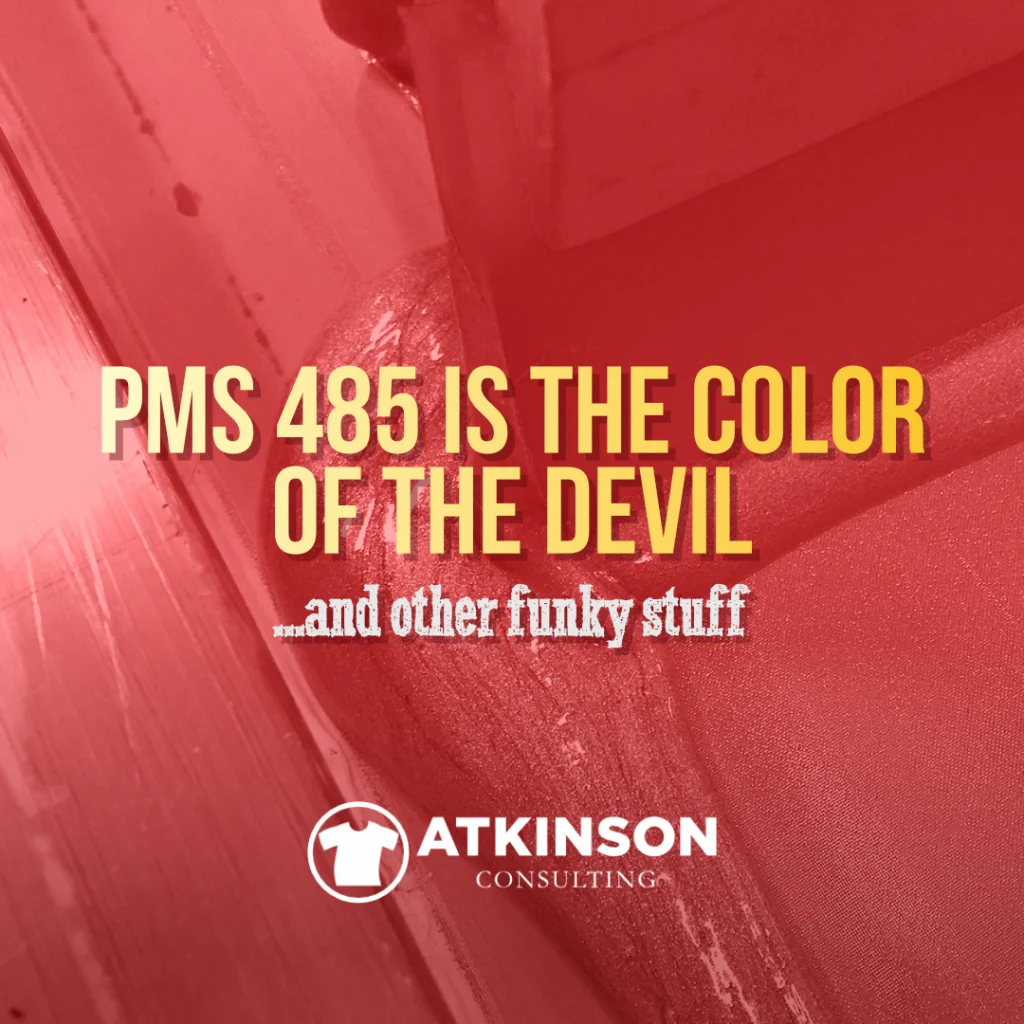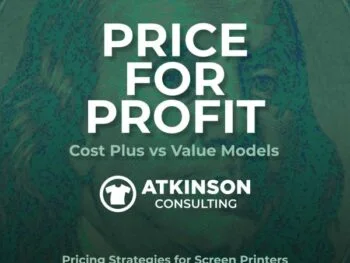PMS 485 Red has to be the most hated color ever invented. If you don’t know why then you haven’t been in the decorated apparel business for long. For me, easily a half-dozen “printing problems” a year caused by this color are due to the fact that when the customer gets the final product they think the red is too “orange”. 100% of the time the client says “It should be redder”.
There always is a big hoohah about the order, but in the end, when we show that the color we printed matches the Pantone book, there’s nothing left but hurt feelings. You can win the debate over the color but still, lose.
I hate it.
There should be a warning sticker or something that accompanies any order that uses PMS 485. It could be a classic Jedi mind trick, (imagine me waving my hand) “this isn’t the red you are looking for”.
So if this red is so unintendedly awful, what other problems are lurking around that we need to watch out for in our industry? Let’s take a look:
Be More Specific About Color
Speaking of Pantone colors, I was at a dinner at this past ISS Long Beach show and a colleague was describing a story where his shop printed an order for several hundred black shirts with gold ink. They sent out some amazing looking metallic gold prints.
Everyone was bright, shiny and perfect.
It was a rush order, and they nailed the delivery too.
I’m sure you can guess the punchline here, as what the customer actually wanted was gold that was PMS 123, which is a yellow-gold. It was a phone order, and they asked for “gold” ink.
How can you screw that up?
Pretty easily actually. This slams an exclamation point down on the need to send the customer approval forms with Pantone color call outs, or at least color names, and proof the job beforehand.
Do you do this every time in your shop?
Heat Control
What’s the quickest way to ramp up a huge dye migration problem?
Not understanding how heat affects the garment during a production run. It’s great that you are using low bleed inks, and are spending time making sure the print is dialed in on the press.
That all fails when your dryer temperature is set too high or your catcher hot stacks the shirts into one big printer-folded pile and places them in a box and tapes it shut.
Another order complete! Next!
Your customer calls you on Friday screaming about the pink ink on the shirt where it should be white. You argue you used the correct ink color! Not my fault you say, “It must be the ink”.
Then you scream at your ink rep and go searching for another white that can solve this problem.
Don’t get into that situation. “Ink Don’t Think”.
Lower your dryer temperature to the correct setting for starters. At the catcher end of the press, you want absolutely cold shirts going into the box, as the box act like an oven and will continue to bake the shirts.
The residual heat in the shirt from the drying process sometimes causes the dye molecules stay active, and this is accelerating your issue. White ink that looked great at the end of your dryer becomes a gigantic financial crisis when your customer receives the shirts a few days later.
The problem isn’t your ink it’s how you are catching your shirts. This is 100% training for your staff.
As the shirts come off the belt, have your catcher stack them into one of four piles on the table. Have a fan blowing on the shirts to cool them down. As more shirts are ready, stack them on top of the short piles. Try to not stack hot shirts on top of each other, just place the next shirt on a new stack.
If you run out of room, transfer the newly cooled shirts to a skid on the floor with some cardboard underneath to protect the shirts from getting dirty. Don’t box anything until you can’t feel the heat at all with your hand.
This simple test can save your butt.
Handwriting
Ever get an order from a customer and wonder if a doctor filled out the form?
This is especially bad with sizing. Don’t interpret 2 XL to mean 2X. (Imagine the chicken scratch illegibility there please) It’s always a good idea to always write out the “X”s.
Don’t write 2X, instead use XXL.
I discovered this the hard way one year trying to interpret someone’s inventory count sheet. Doing a CSI investigation on why your totals are off and discovering it’s due to poor penmanship and assuming something about what was jotted down will teach you a good lesson regarding following up.
Sometimes a 9 can look like a 7. Some best practices to counteract this problem are obvious.
Anything you can’t read, ask questions…and always send an order acknowledgment to the client to double check that everything was entered correctly.
You may want to include a note stating that there were some challenges reading the information provided to reinforce the need to review everything.
The “Blessings” of the Internet
Sure, you post some great designs up on the internet where everyone can see them.
Trouble is, everyone can see them.
And by everyone, I mean the scumbags that blatantly steal designs. If you’ve done that and you are reading this article, yes I just called you a scumbag.
Clicking “Save As” when you see an image doesn’t make you a designer. It makes you something else.
I know it’s tempting. You fundamentally lack talent, and talented people post great pieces all the time on the internet.
The internet can be just like cruising down an aisle in a grocery store sometimes. A little of this, a little of that, and you pluck out whatever you happened to be looking for at the time.
Ten minutes later, you are all set!
Except the problem is that there’s someone behind that piece you just copied and that someone worked for hours on that image. And really, if you think about it, for years crafting their creative voice so it could sing a sweet song.
Don’t have that talent, but would like to use that image?
Here’s an idea, call the designer! Maybe they can do something similar for you? Maybe they could license that image?
Just don’t copy that image and then pass it off as your own.
That, I’m afraid, is the very definition of being a scumbag.
Always Check the Packing Slip
That isn’t a box of shirts. It is a box of money.
Look at your receiving department and how they operate. Are they counting things in properly?
Call me a cynic, but I don’t trust anything on the receiving dock to be correct.
Good thing everything usually comes with a packing slip. This isn’t just a piece of paper, it a lifesaver should something be off with an order.
When goods come in, count them and check the packing slip to be sure that you have what was ordered.
Every time. The day it comes in. Regardless of how busy you are. No exceptions.
For gigantic orders, this means you need to crack open each box and look inside. Does that skid of G-2000 Royal Blue Mediums each have the right color and style in each box?
The only way to know is to look.
Whoever counts initials the bottom right corner of the slip, and then you mark the goods received into your system. The packing slip is filed by receiving date in case there’s an issue later.
If you don’t establish what’s in the box, the same day you receive it, you are begging for problems later.
By later, I mean at the press when that order is due to ship and you discover that one box of Royal Blue Mediums actually has Forest Green shirts inside.
Whoops.
Customer Service?
Let’s face it, I am a customer service driven person.
I hate it when I see a problem with another company, especially ones that I deal with on a regular basis.
All companies should adopt the strategy of seeing themselves with the “voice of the customer” in mind.
What is frustrating? Can we make ordering easier? Is important information easy to obtain? Are staffing levels correct, with fully trained employees ready to help? Do they keep inventory levels accurate and well stocked so when you need something it is available? How would you rate the customer service levels with your suppliers?
What about in your shop?
I was at a trade show last year and a friend suggested that the decorated apparel industry is run with an unmatched level of arrogance in any other field.
What he meant was that suppliers and manufacturers don’t do a good job of listening to their customers. It’s an arms race for products nobody wants or needs, but for some major problems, the questions go unanswered.
He said that everything is just pushed down to the printers or embroiderers, with very little interaction during the developmental stage for the products.
Do you agree?
Is PVC-free Ink Really Needed?
PVC, if you didn’t know, stands for polyvinyl chloride and is the third most commonly produced synthetic plastic polymer in the world, after polyethylene and polypropylene.
PVC is everywhere.
There is a wave of ink coming our way in the industry that is PVC-free and it’s all being driven by the shoe companies that also print shirts.
You know who.
I can understand the challenge of phthalates, as there is a medical reason for wanted to mitigate that issue.
Switching over from “classic” ink to another formula that resolved the phthalate issue may have been necessary, but was extremely expensive and cumbersome for our print community.
That was only a few years ago. Now, there is a considerable amount of noise in the industry about moving to inks that are PVC-free.
What’s not being discussed though is why this is necessary.
Are we solving a problem that doesn’t really exist?
The water pipes in my house, the IV bag in the hospital, and a good portion of the plastic I interact with every day are all made from PVC. If it is ok to drink from a cup or get medicine delivered in a hospital, why can’t it be in the ink on a t-shirt that is far more innocuous?
Maybe I’m just not educated enough on the subject, but I’d love to get that information.
Embroidery Stabilizer Update
Last year I wrote about the effort that I’ve been putting in trying to find a way to recycle the embroidery stabilizer material that is discarded after the trimming process. This material is also called Pellon, and embroiderers all over the world are just throwing this material into the trash and it ends up in landfills everywhere.
If you missed the article, click here.
I’m still banging away at trying to find a solution, and I give samples out to people at least once a month, as different people seem to think that they may have an answer. So far, the leading idea is to bale the material and then once enough is collected ship it to an alternative energy plant or concrete kiln to be used as fuel for energy. This could work but has some inherent challenges that we haven’t overcome yet. Not to mention it is not cost-neutral, so we would be losing money doing it.
A few years ago I read an article about an entrepreneur who wanted to start a worm farm business. To get going, he went around and collected coffee grounds from all the coffee houses in his area.
In a short period of time, he had all the basic material he needed to start his business, virtually for free. Somebody, somewhere could use this embroidery stabilizer material like the coffee grounds to start their business. It’s free material, available in large quantities and it is everywhere.
C’mon smart people! Let’s find something to do with pellons. You could be the next “worm king”.
Alternatively, could an embroidery machine be built to sew without using the stabilizer material at all? Imagine how much time, energy and cost savings your shop would have if this step was avoided. C’mon even smarter people! Get your engineering brain going, please!
Let’s hear from you! What drives you crazy? Drop a note in the comments section.
Download this FREE eBook Today!

Top 10 Workflow Tips is a FREE eBook that shows you how the top shops in the industry increase their production efficiency.
This eBook is a must-have for any screen-printer that wants to improve.
Simply click this link and download the eBook.
Get better today!
.





14 comments
Steve Bremner
40 years decorating t’s this year, and never gave it a thought, go figure. Just give us the number, or a sample to match…
John Crist
Regarding PVC: I’m not a chemist but this is my understanding: The PVCs in the screenprinting inks themselves are not the real danger in the screenprinting plant since they are “encapsulated” in the plasticized ink. There may be some danger of toxic fumes being released as inks are dried. However, there is much more danger to the environment and workers upstream and downstream from the printing process; the plants where the poly vinyl chloride is produced can release toxins into the community and may put people working with it at risk. Then there is the downstream danger of PVCs being disposed of, possibly by leaching from landfills but especially if at any point it is burned, which creates very toxic fumes. I think the drive to eliminate PVCs from screenprinting is part of the larger drive to eliminate PVCs in general. I did a quick Google search and here is the first article that came up, which seemd pretty comprehensive. http://chej.org/wp-content/uploads/Documents/PVC/bad_news_comes_in_threes.pdf
I’d like to hear any other views that may enlighten me.
atkinsontshirt
That’s exactly the answer I was looking for – THANKS John!!
Erich Campbell
I hate almost all ‘color names’ – One of my pet peeves is ‘Royal Blue’- I’ve seen everything from Process Blue to Purple called ‘Royal Blue’ – I will march people to the thread rack if I must, but I never trust a Royal.
Marie
You hate “royal” more than “teal?”
Erich Campbell
Just because I hear it more frequently. Truly, I hate most imprecise color names. I’ve had times where I’ve sent an off-site client to the paint department of a home store to grab a chip- at least then I can go get the same chip and have half a chance at a match- Poor Man’s Pantone.
atkinsontshirt
Actually one of the best and easiest ways to plan a color collection for a project is to use the paint department at a hardware store. They have dozens of paint schemes that are all pre-coordinated to match together. They usually have 3 – 5 different colors per card. Grab one of each and use them to plan out your next project. It’s a great jumpstart.
Erich Campbell
This is true- there’s a lot of research behind those schemes. They are well worth checking out.
atkinsontshirt
Oh yeah? I hate “reflex blue” – what a crappy color – and it’s never the same from one ink company to the next
alphastare
Gold…always clarify that one!
Marie
We ask “Boston Bruins gold” or “San Francisco 49’ers gold?” That usually gets us a little closer.
John Sheridan
Sorry but this article was a little faded, I expected something a little brighter, ya know kind of how bright it looks on my screen, tell you what.. I’ll go ahead and take this article this time, but how about you brighten it up a little for next time and let’s go ahead and give me a credit for the 3 minutes It took to read it, thanks!
Marie
“How it looks on my screen.” Love it. Maybe you should look at it on your phone instead. 😉
tmdesigncorp
Amen I hate that color